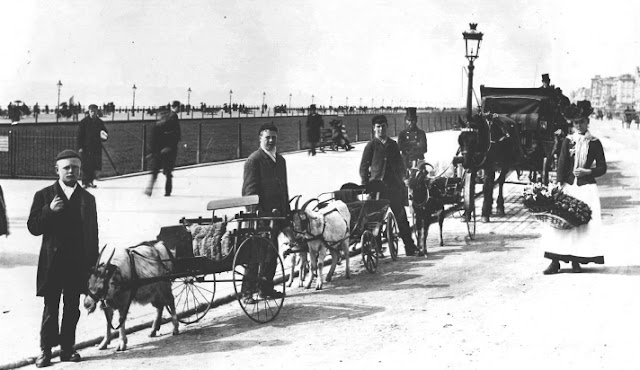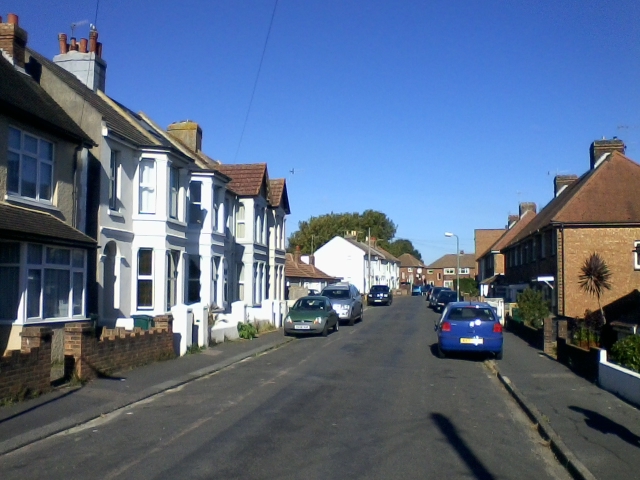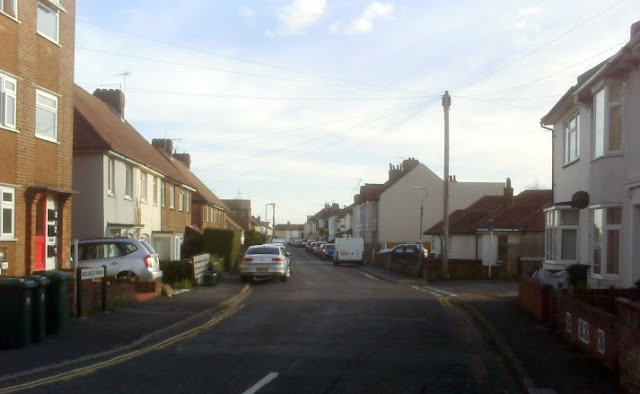 |
| copyright © D. Sharp 'Jubilee Terrace' in Wolseley Road. |
Mr Barnes the builder
 |
| copyright © D. Sharp 'Jubilee Terrace' |
Joseph David Barnes, builder, ensured that his part in the development of Wolseley Road would be remembered for ever. His initials ‘JDB’, plus the date ‘1897’, are still to be seen on the terraced housing on the west side of the road.
They are more easily seen on the southern block because they have become eroded on the northern block with only the ‘J’ and ‘18’ surviving. Barnes, as a patriotic Englishman, decided his building endeavours should commemorate the historic year of 1897 – Queen Victoria’s Diamond Jubilee – by naming the south block of houses ‘Jubilee Terrace’ and the northern one ‘Diamond Terrace’.
 |
| copyright © D. Sharp 'Diamond Terrace' |
It is likely that Mr Barnes added further decorations to the facades because at number 26 there used to be a cartouche above the front door, although nothing was visible within it. Mrs Winifred Martin (later Mrs Attree) rented the house from around 1944 until her death in 1968, and afterwards her daughter and family occupied the premises. Since then the house has been renovated, and all traces of the cartouche have vanished.
Originally, the houses in the southern block were known as 1, 2, 3, 4, and 5 Jubilee Terrace, but when Wolseley Road was re-numbered, they became numbers 29, 31, 33, 35, and 37. The houses have tiny porch roofs over the front door, some free-standing, and others resting on thin supports.
The land on which Barnes built his houses originally belonged to Frederick Peters and Peters sold the land to Zachariah James Batterbee who already owned land in Wolseley Road on which houses (later numbering 1, 3, 5, and 7) were built. Batterbee then sold the former land to John Walter of Southwick, a retired licensed victualler. It was Walter who on 26 July 1897 sold the land for £300 to Joseph David Barnes. The land measured north to south on the east side 84 feet, on the west side 91 feet 6 inches, from east to west on the north side 251 feet 6 inches, and on the south side 226 feet.
 |
| copyright © D. Sharp Looking north in Wolseley Road to 'Diamond Terrace' on the left with the slate porches. |
In 1897 Barnes was recorded as owning one house, a shop, and four cottages. But in 1898 he mortgaged the five properties in Diamond Terrace for £1,000 with well-heeled Brighton spinsters Jessie James (!) and Belinda James.
It should be noted that Barnes, and other early builders, were operating before they needed planning permission from the local authority – the first plans for Wolseley Road to be logged with the council did not take place until 1899.
Road Name
 |
| copyright © D. Sharp View of Wolseley Road from Number 1 looking north with 'Jubilee Terrace' on the left with the slate porches |
It is generally assumed that the road was named after the very famous Victorian Field Marshal Garnet Joseph, Viscount Wolseley (1833-1912) who seemed to have taken part in almost every theatre of war in which the British Empire was involved. Gilbert and Sullivan parodied Wolseley in the Pirates of Penzance as ‘the very model of a modern Major-General’, but when Wolseley died he was considered to be such a national hero that he was laid to rest beside Wellington in St Paul’s Cathedral.
 |
| copyright © D. Sharp 83-89 Wolseley Road on the corner of Park Crescent |
However, as regards Portslade, it is interesting to note that in 1897 H. M. Wolseley owned numbers 83 to 89 Wolseley Road. Is that a coincidence, or did he have something to do with the road naming? It certainly has more of a ring to it than Barnes Road. But perhaps builder Joseph David Barnes was placated by having a small road in Portslade named after him.
Gravel Pit
According to the Ordnance Survey Map of 1898 there was a gravel pit between Wolseley Road and Crown Road. When houses came to be built in the area the road received the delightful name of Pitt Street, hardly a desirable address.
Anecdotes
There are some lovely anecdote originating from the Ford family. The story goes that an eccentric resident of Wolseley Road known as Madame Manetta used to run a popular tourist attraction on Hove sea-front during the summer months that involved giving children rides along the promenade in little carts pulled by goats. Madame Manetta took great care of her goats to the extent that during the winter they stayed with her – inside the house.
 |
| copyright ©
Royal Pavilion & Museums, Brighton & Hove Edwardian photograph of 'Goat Carts' waiting for customers by Brunswick Lawns, Hove |
Alfred and Lucy Ford moved from Hove to Wolseley Road in 1903. They already had two children, and two more were born – Ethel in 1904 and Sid in 1907 – there were to be six children altogether. The Ford youngsters and other local children could not resist teasing Madame Manetta who was not amused. Indeed, she threatened to send for a policeman to sort them out. When one of the Ford boys was ill in bed with scarlet fever, he happened to glance out of the window, and saw a policeman striding along the bridle-path at the back of the houses. He was terrified and shouted out ‘Don’t let him take me, Mum.’
After the fifth child arrived in 1914, the Fords began to feel somewhat cramped in their Wolseley Road house, and in 1918 they moved to more spacious quarters in Norway Street.
Road Matters
In 1903 some 457 feet of Wolseley Road was declared a public highway.
In November 1910 it was proposed to widen a portion of the road, and Mr Hillman, owner of the land affected, offered to give Portslade Council some of it if they would undertake to make up the road. Walter Hillman was a very prominent man of business with his fingers in many a pie – he was also responsible for building many fine houses in St Andrew’s Road.
In June 1995 it was stated that impatient lorry drivers would no longer be able to use Wolseley Road as a rat-run to avoid congestion of the A27 Old Shoreham Road because notices had been erected banning heavy good vehicles.
Property Transactions Regarding Numbers 1, 3, 5, and 7
On 23 January 1883 an agreement was drawn up between Zachariah James Batterbee who sold some land to Charles Trusler, builder, of 9 Wellington Terrace, for £134-8s. The land was situated on the west side of Wolseley Road with a 64-ft frontage to the road and an 80-ft depth, east to west. Trusler agreed to build four houses on the site. Later on in the same year, Trusler took out a mortgage for £500 with Edward James Withers of Buckingham Palace Road, London, gentleman. In 1905 Withers transferred the mortgage to George Thomas Dutton.
Meanwhile, Batterbee had died in 1884. On 10 October 1899 Dutton sold the land and four houses to Hannah Rebecca Holloway of 41 Ventnor Villas, Hove. These houses were originally numbered as 1, 2, 3, and 4, but by 1918 had been re-numbered as 1, 3, 5, and 7.
In 1918 Holloway sold the four houses for £350 to George Brigden. It seems that Brigden was never resident for long at one house because with each transaction he made, he was noted as living at a different address, for example:
1923 – a flat in Palmeira Mansions, Hove
1924 – Red House, Lansdowne Road, Hove
1926 – 11 Norfolk Terrace, Brighton
In 1924 Brigden sold 1 Wolseley Road for £150 to Alexander Ebenzer Cook, a coachman. But the deal must have fallen through because in 1926 he sold numbers 1, 3, 5, and 7 Wolseley Road for £600 to John Alfred Kent, baker, of 66 Goldstone Villas. It seems that Kent either made a bad investment, or fell upon hard times, because the following year he sold the houses for £475 to Alfred Ernest Ball of 20 Connaught Road, Hove. It was thus a considerable loss for Kent, who by then was recorded as being a retired baker living at 37 Blatchington Road, Hove.
At least Ball made a modest profit when he decided to sell the houses in 1928 for £495 to Edward J. Salvage. The latter gentleman had considerable investments in Portslade because at the time of his death he owned four more houses in Wolseley Road, besides other properties in Gardener Street and Barnes Road.
In 1952 number 5 was sold, but when Salvage died in 1965, the other three properties were still in his ownership. They were sold as freehold investments at the Old Ship Hotel, Brighton, on 10 November 1965.
Number 1 Wolseley Road was described as a two-storey bay-fronted house on the corner of Gardener Road, with three bedrooms, two sitting rooms, and outside WC. The other two were of similar proportions. The sale particulars were as follows:
Number 1 (lot 8) sold for £600
Number 3 (lot 9) sold for £500
Number 7 (lot 10) sold for £625
Number 31 (lot 12) sold for £650
Number 33 (lot 13) sold for £775
The properties were purchased by Boysbrooks Investments of 52 Tongdean Avenue, registered office at 8 The Drive, Hove. In addition the company purchased numbers 29, 35, and 37 Wolseley Road that had also been the property of Edward Salvage.
 |
| copyright © J Middleton The Stanley Arms at 47 Wolseley Road was erected in around 1881 |
Portslade Planning Approvals
1899 – W. D. Holden, two cottages
1899 – G. Wicks, four cottages
1900 – Wicks & White, six houses
1902 – J. Holland, six houses
1906 – G. Wicks, gymnasium
1919 – Mrs G. Wicks, conversion of laundry into bungalow
1923 – W. Hunt, bungalow
1929 – W. H. Green, four houses, numbers 42-48
1930 – A. J. Heather, Meeting Room
1930 – M. Winstanley, one house
1933 – Baker, two blocks, four houses, numbers 68-82
1934 – M. A. Lawson, fifteen houses in Wolseley Road and Crown Road
1937 – A. E. Painter & J. S. Gibson, eight houses, numbers 52-66
1956 – Eight houses, and six bungalows in Wolseley Road and Pitt Street (in the 1927 Street Directory Pitt Street was noted as being reached from Park Crescent)
Sources
Middleton, J, Encyclopaedia of Hove and Portslade
Middleton, J. Portslade and Hove Memories (2004)
Portslade Minute Books
Royal Pavilion & Museums, Brighton & Hove
Royal Pavilion & Museums, Brighton & Hove
The Keep
ACC 2499/12 – Re Wolseley Road, Portslade
Copyright © J.Middleton 2018
page layout by D. Sharp
page layout by D. Sharp


